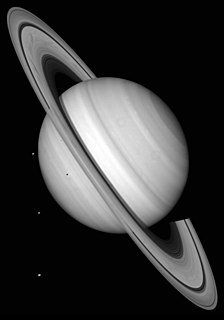
The rings of Saturn are the most extensive ring system of any planet in the Solar System. They consist of countless small particles, ranging in size from micrometers to meters, that orbit around Saturn. The ring particles are made almost entirely of water ice, with a trace component of rocky material. There is still no consensus as to their mechanism of formation. Although theoretical models indicated that the rings were likely to have formed early in the Solar System's history, new data from Cassini suggest they formed relatively late.

The rings of Neptune consist primarily of five principal rings and were first discovered on 22 July 1984 by Patrice Bouchet, Reinhold Häfner and Jean Manfroid at La Silla Observatory (ESO) in Chile during an observing program proposed by André Brahic and Bruno Sicardy from Paris Observatory, and at Cerro Tololo Interamerican Observatory by F. Vilas and L.-R. Elicer for a program led by William Hubbard. They were eventually imaged in 1989 by the Voyager 2 spacecraft. At their densest, they are comparable to the less dense portions of Saturn's main rings such as the C ring and the Cassini Division, but much of Neptune's ring system is quite tenuous, faint and dusty, more closely resembling the rings of Jupiter. Neptune's rings are named after astronomers who contributed important work on the planet: Galle, Le Verrier, Lassell, Arago, and Adams. Neptune also has a faint unnamed ring coincident with the orbit of the moon Galatea. Three other moons orbit between the rings: Naiad, Thalassa and Despina.
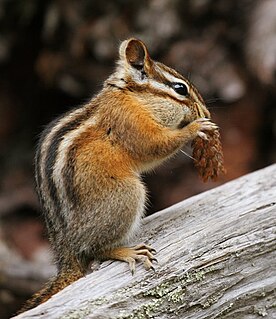
The least chipmunk is the smallest species of chipmunk and the most widespread in North America.

Omega Virginis is a solitary star in the zodiac constellation Virgo. It has an apparent visual magnitude of +5.22, which is bright enough to be faintly visible to the naked eye. Based upon an annual stellar parallax shift of 6.56 milliarcseconds, it is located about 500 light years from the Sun.

Gastrophryne olivacea, the Great Plains narrow-mouthed toad or western narrow-mouthed toad, is a species of microhylid frog found throughout much of the south-central United States from Nebraska south through Texas, and into northern Mexico. Though not a true toad, it is often referred to as such because it is terrestrial.
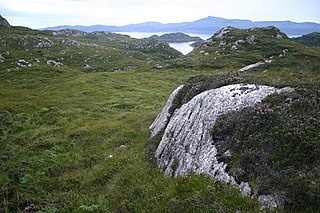
In geology, basement and crystalline basement are the rocks below a sedimentary platform or cover, or more generally any rock below sedimentary rocks or sedimentary basins that are metamorphic or igneous in origin. In the same way, the sediments or sedimentary rocks on top of the basement can be called a "cover" or "sedimentary cover".

The narrow-bridged musk turtle is a species in of turtle in the family Kinosternidae. The species is endemic to Central America and Mexico.

The gecko catshark is a species of catshark, part of the family Scyliorhinidae, native to the northwestern Pacific Ocean from southern Japan to Taiwan, and possibly also off Vietnam. It is a common, demersal species found at depths of 100–900 m (330–2,950 ft). Its body is slender, with a pattern of dark saddles and blotches. The dorsal and caudal fins are edged in white, and there is a prominent crest of enlarged dermal denticles along the dorsal edge of the caudal fin. The gecko catshark is a schooling, opportunistic predator of bony fishes, cephalopods, and crustaceans. It is oviparous, with females producing two vase-shaped egg capsules at a time. This species is captured as bycatch, but does not appear to be threatened by fishery activities at present and has been assessed as Least Concern by the International Union for Conservation of Nature (IUCN).
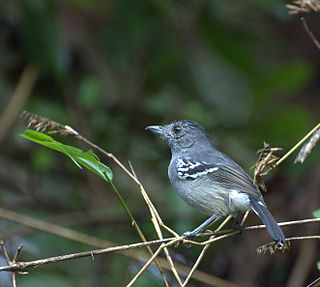
The variable antshrike is a species of bird in the family Thamnophilidae found widely in South America. It is, as its common name suggests, arguably the species of antbird with the most variable plumage.

Corispermum is a genus of plants in the family Amaranthaceae. Common names given to members of the genus involve bugseed, tickseed, and tumbleweed. In general, these are erect annual plants with flat, thin leaves and topped with inflorescences of flowers with long bracts. Bugseeds are native to North America and Eurasia, but little is known about their taxonomy and distribution.
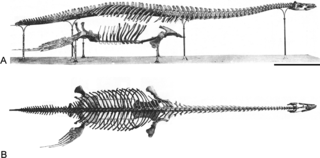
Brancasaurus is a genus of plesiosaur which lived in a freshwater lake in the Early Cretaceous of what is now North Rhine-Westphalia, Germany. With a long neck possessing vertebrae bearing distinctively-shaped "shark fin"-shaped neural spines, and a relatively small and pointed head, Brancasaurus is superficially similar to Elasmosaurus, albeit smaller in size at 3.26 metres (10.7 ft) in length.
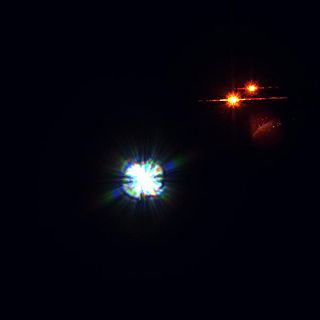
HD 141569 is an isolated Herbig Ae/Be star of spectral class A2Ve approximately 320 light-years away in the constellation of Libra. The primary star has two red dwarf companions at about nine arcseconds. In 1999, a protoplanetary disk was discovered around the star. A gap in the disk speculate a possible extrasolar planet forming in the disk.
14 Aquarii is red giant star. 14 Aquarii is the Flamsteed designation; it also bears the variable star designation IW Aquarii. It is a semiregular variable with an amplitude of less than a tenth of a magnitude, and shows variations on a timescale of just one day.
BD Camelopardalis is an S star and symbiotic star in the constellation Camelopardalis. It was recognized as a spectroscopic binary star in 1922, and its orbital solution published in 1984; it has a 596-day orbital period. A spectroscopic composition analysis was done of the red giant primary star in 1986.
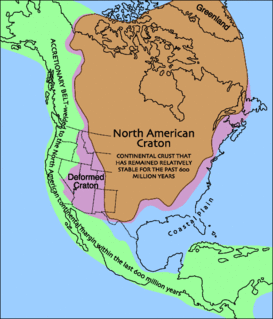
Laurentia or the North American Craton is a large continental craton that forms the ancient geological core of North America. Many times in its past, Laurentia has been a separate continent, as it is now in the form of North America, although originally it also included the cratonic areas of Greenland and also the northwestern part of Scotland, known as the Hebridean Terrane. During other times in its past, Laurentia has been part of larger continents and supercontinents and itself consists of many smaller terranes assembled on a network of Early Proterozoic orogenic belts. Small microcontinents and oceanic islands collided with and sutured onto the ever-growing Laurentia, and together formed the stable Precambrian craton seen today.
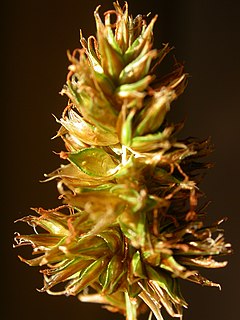
Carex hoodii is a species of sedge known by the common name Hood's sedge. It is native to western North America from Alaska to Nunavut to California to South Dakota, where it grows in dry to moist habitat in forests and on mountain slopes.

The Iberian Plate with the microcontinent Iberia encompassed not only the Iberian Peninsula but also Corsica, Sardinia, the Balearic Islands, and the Briançonnais zone of the Penninic nappes of the Alps. Nowadays, the Iberian plate is a part of the Eurasian plate.
Sewing is the craft of fastening or attaching objects using stitches made with needle and thread. Sewing is one of the oldest of the textile arts, arising in the Paleolithic Era. Although usually associated with clothing and household linens, sewing is used in a variety of crafts and industries, including shoemaking, upholstery, sailmaking, bookbinding and the manufacturing of some kinds of sporting goods. Sewing is the fundamental process underlying a variety of textile arts and crafts, including embroidery, tapestry, quilting, appliqué and patchwork.

The Corispermoideae are a subfamily of the Amaranthaceae, formerly in family Chenopodiaceae.
Morrosaurus is an extinct genus of herbivorous ornithischian dinosaur member of the Euornithopoda, that lived in the late Cretaceous in the Antarctica. The only known species is the type Morrosaurus antarcticus.
















